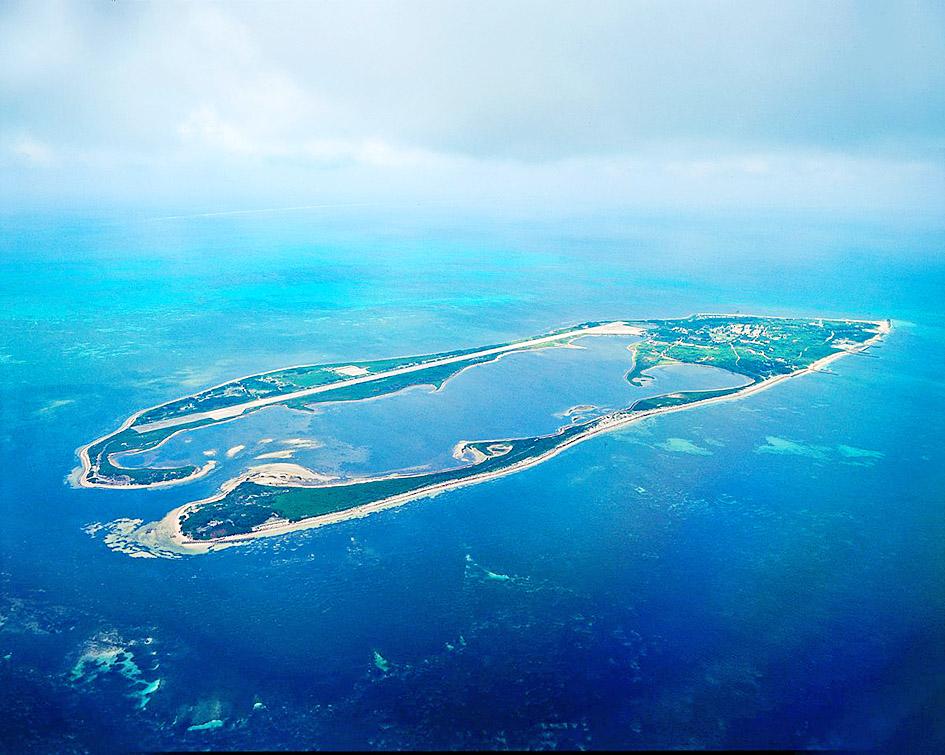Minister of National Defense Yen De-fa (嚴德發) yesterday called on Beijing to respect international aviation rules and refrain from undermining air travel after Hong Kong air traffic controllers on Thursday morning warned off a Taiwanese flight.
A military chartered supply flight operated by Uni Air (立榮航空) from Kaohsiung to the Taipei-controlled Pratas Islands (Dongsha Islands, 東沙群島) in the South China Sea was forced to turn back on its way to the disputed islands, where 250 Taiwanese coast guard personnel are deployed, the Civil Aeronautics Administration (CAA) said.
Hong Kong air traffic controllers denied the Uni Air ATR2-600 aircraft authorization to enter the Hong Kong Flight Information Region (FIR) because of “dangerous activities” being conducted in the area, the CAA said.

Photo courtesy of the Water Resources Agency via CNA
The ministry did not find any Chinese military exercises being conducted in the region, Yen said.
There was “nothing abnormal” there, he said, adding that the Chinese Maritime Safety Administration had not issued an aviation ban, meaning that normal passage was allowed in the region for any flight meeting international aviation regulations.
“We hope the Chinese authorities will respect the rules set by international aviation organizations, take international aviation safety seriously and refrain from destroying the international aviation order,” Yen said.
The supply plane took off from Kaohsiung International Airport at 9:05am, was turned away about 40 minutes later and returned to the airport at 10:22am, the CAA said.
About 50 to 60 nautical miles (about 93km to 111km) before entering the Hong Kong FIR, air traffic controllers told the pilot that the aircraft was not allowed to enter, the CAA said.
The pilot tried to ask when the “dangerous activities” would end, but received no response and eventually decided to return to Kaohsiung, it said.
The Pratas Islands — administered by Taiwan, but also claimed by China — are about 310km southeast of Hong Kong and are within its FIR.
It has been standard practice for Taiwanese air traffic controllers to inform their Hong Kong counterparts whenever a plane in the Taipei FIR is about to enter the Hong Kong region and is about 20 to 30 nautical miles away.
Hong Kong air traffic controllers should have issued an advance “notice to airmen” if there had been hazards along the route, but no such notice was given on Thursday, the CAA said.
The Hong Kong Civil Aviation Department yesterday said that it received a notice of the aircraft’s planned entry into the region and reminded Taiwan’s air traffic controllers that the aircraft must stay above the minimum safe altitude.
Taiwan’s air traffic control center told it to cancel the request for the Uni Air flight to enter the FIR, the Hong Kong department said, adding that it followed protocol in handling the situation.
The Pratas Islands have taken on extra significance since pro-government protests began in Hong Kong last year.
Taiwan has intercepted at least one boat near the region carrying people fleeing from Hong Kong trying to make their way to Taiwan.
Some Taiwanese officials have expressed concern that China could attempt to seize the Pratas Islands, a drastic escalation of tensions that could lead to war.
Additional reporting by Reuters

The US government has signed defense cooperation agreements with Japan and the Philippines to boost the deterrence capabilities of countries in the first island chain, a report by the National Security Bureau (NSB) showed. The main countries on the first island chain include the two nations and Taiwan. The bureau is to present the report at a meeting of the legislature’s Foreign Affairs and National Defense Committee tomorrow. The US military has deployed Typhon missile systems to Japan’s Yamaguchi Prefecture and Zambales province in the Philippines during their joint military exercises. It has also installed NMESIS anti-ship systems in Japan’s Okinawa

‘WIN-WIN’: The Philippines, and central and eastern European countries are important potential drone cooperation partners, Minister of Foreign Affairs Lin Chia-lung said Minister of Foreign Affairs Lin Chia-lung (林佳龍) in an interview published yesterday confirmed that there are joint ventures between Taiwan and Poland in the drone industry. Lin made the remark in an exclusive interview with the Chinese-language Liberty Times (the Taipei Times’ sister paper). The government-backed Taiwan Excellence Drone International Business Opportunities Alliance and the Polish Chamber of Unmanned Systems on Wednesday last week signed a memorandum of understanding in Poland to develop a “non-China” supply chain for drones and work together on key technologies. Asked if Taiwan prioritized Poland among central and eastern European countries in drone collaboration, Lin

NO CONFIDENCE MOTION? The premier said that being toppled by the legislature for defending the Constitution would be a democratic badge of honor for him Premier Cho Jung-tai (卓榮泰) yesterday announced that the Cabinet would not countersign the amendments to the local revenue-sharing law passed by the Legislative Yuan last month. Cho said the decision not to countersign the amendments to the Act Governing the Allocation of Government Revenues and Expenditures (財政收支劃分法) was made in accordance with the Constitution. “The decision aims to safeguard our Constitution,” he said. The Constitution stipulates the president shall, in accordance with law, promulgate laws and issue mandates with the countersignature of the head of the Executive Yuan, or with the countersignatures of both the head of the Executive Yuan and ministers or

CABINET APPROVAL: People seeking assisted reproduction must be assessed to determine whether they would be adequate parents, the planned changes say Proposed amendments to the Assisted Reproduction Act (人工生殖法) advanced yesterday by the Executive Yuan would grant married lesbian couples and single women access to legal assisted reproductive services. The proposed revisions are “based on the fundamental principle of respecting women’s reproductive autonomy,” Cabinet spokesperson Michelle Lee (李慧芝) quoted Vice Premier Cheng Li-chiun (鄭麗君), who presided over a Cabinet meeting earlier yesterday, as saying at the briefing. The draft amendment would be submitted to the legislature for review. The Ministry of Health and Welfare, which proposed the amendments, said that experts on children’s rights, gender equality, law and medicine attended cross-disciplinary meetings, adding that